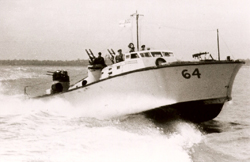Robert Peverell Hichens
Lieutenant Commander Robert Peverell Hichens, DSO & Bar, DSC & Two Bars (2 March 1909 – 13 April 1943) was the most highly decorated officer of the Royal Navy Volunteer Reserve (RNVR),[1][2] being awarded two Distinguished Service Orders, three Distinguished Service Crosses and three Mentions in Despatches.
[2] Before the Second World War, Hichens was a keen sportsman who rowed for Magdalen College, Oxford, and competed in the Double sculls at the Henley Regatta.
[5] In 1919, following the Great War, the family returned to the Northampton area, and Hichens was sent to a prep school nearby until 1921, when he was enrolled in Marlborough College.
[6] In 1922, Hichens' father, by now a consulting physician at Northampton General hospital, retired and the family moved to Guernsey in the Channel Islands, purchasing Havelet House just outside Saint Peter Port.
[12] In June 1933, after his mother's death, Hichens inherited half of his father's estate and Bodrennick House, and at the same time completed his articles.
[17] In 1935, he purchased a 1.4-litre Aston Martin touring car and a Riley which he used to compete in hill climbs at Beggers Roost in Somerset.
[17] Then in 1936, he purchased a 2-litre Aston Martin Speed Model—one of six built for the Ulster TT and 24 Hours of Le Mans race that year.
[21] Robert Hichens applied to transfer from the Territorial Army to the Royal Naval Volunteer Reserve (RNVR) in the summer[when?]
of 1930, and eventually transferred to the Royal Naval Volunteer Supplementary Reserve in 1936, which was formed from yachtsmen sufficiently knowledgeable about the sea to be considered suitable for a commission.
[26] On 29 May 1940, Hichens was informed that the British Expeditionary Force were being evacuated from Dunkirk in Operation Dynamo and that Niger would be leaving to assist.
[28] For his work on the beaches in the withdrawal of the Allied armies from Dunkirk, Hichens was awarded the Distinguished Service Cross (DSC).
[29] Having asked for a transfer to Coastal Forces Hichens was sent to HMS Osprey at Portland for training on Motor Anti-Submarine Boats (MASB).
[31] These boats were lightly armed with two twin Vickers .50 machine guns and depth charges and had a top speed of about 30 knots.
As each boat needed to select a radio call sign, Hichens could not think of anything suitable and Lieutenant Arty Shaw suggested Hitch, which stuck and remained with him for the rest of his time with the coastal forces.
[34] The 6th MGB Flotilla was based at HMS Beehive in Felixstowe from April 1941, where they were tasked to engage German E boats raiding east coast convoys.
The armament was soon standardized with two twin Vickers .50 machine guns each side of the bridge, an Oerlikon 20 mm cannon mounted aft, and depth charges.
[45] Other members of the flotilla were awarded one Distinguished Service Medal (DSM) and five others were Mentioned in Dispatches (MID) for the action.
They passed twice at high speed before losing contact, but twice during the night they located them and eventually carried out depth charge attacks.
Ordered to engage E Boats using Cherbourg as a base they found a convoy of naval trawlers escorting a small tanker.
[57] Both the DSO and the Bar were presented during the same investiture at Buckingham Palace on 22 September 1942, while other members of the flotilla were awarded a Conspicuous Gallantry Medal and four MIDs for the action.
[59] The flotilla, accompanied by four MTBs and escorting mine laying Motor Launches (ML), were next in action over the night of 27/28 February 1943.
Detecting two trawlers they engaged them leaving one on fire, but as they withdrew MGB 77 was hit, killing Hichens outright and wounding three others on the bridge.

